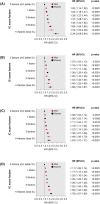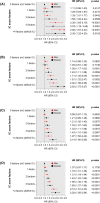Association of intrinsic capacity with incidence and mortality of cardiovascular disease: Prospective study in UK Biobank
- PMID: 37434422
- PMCID: PMC10570093
- DOI: 10.1002/jcsm.13283
Association of intrinsic capacity with incidence and mortality of cardiovascular disease: Prospective study in UK Biobank
Abstract
Background: The World Health Organization proposed the concept of intrinsic capacity (IC; the composite of all the physical and mental capacities of the individual) as central for healthy ageing. However, little research has investigated the interaction and joint associations of IC with cardiovascular disease (CVD) incidence and CVD mortality in middle- and older-aged adults.
Methods: Using data from 443 130 UK Biobank participants, we analysed seven biomarkers capturing the level of functioning of five domains of IC to calculate a total IC score (ranging from 0 [better IC] to +4 points [poor IC]). Associations between IC score and incidence of six long-term CVD conditions (hypertension, stroke/transient ischaemic attack stroke, peripheral vascular disease, atrial fibrillation/flutter, coronary artery disease and heart failure), and grouped mortality from these conditions were estimated using Cox proportional models, with a 1-year landmark analysis to triangulate the findings.
Results: Over 10.6 years of follow-up, CVD morbidity grouped (n = 384 380 participants for the final analytic sample) was associated with IC scores (0 to +4): mean hazard ratio (HR) [95% confidence interval, CI] 1.11 [1.08-1.14], 1.20 [1.16-1.24], 1.29 [1.23-1.36] and 1.56 [1.45-1.59] in men (C-index = 0.68), and 1.17 [1.13-1.20], 1.30 [1.26-1.36], 1.52 [1.45-1.59] and 1.78 [1.67-1.89] in women (C-index = 0.70). In regard to mortality, our results indicated that the higher IC score (+4 points) was associated with a significant increase in subsequent CVD mortality (mean HR [95% CI]: 2.10 [1.81-2.43] in men [C-index = 0.75] and 2.29 [1.85-2.84] in women [C-index = 0.78]). Results of all sensitivity analyses by full sample, sex and age categories were largely consistent independent of major confounding factors (P < 0.001).
Conclusions: IC deficit score is a powerful predictor of functional trajectories and vulnerabilities of the individual in relation to CVD incidence and premature death. Monitoring an individual's IC score may provide an early-warning system to initiate preventive efforts.
Keywords: biological ageing; biomarkers; incident pathologies; intrinsic capacity; mortality.
© 2023 The Authors. Journal of Cachexia, Sarcopenia and Muscle published by John Wiley & Sons Ltd on behalf of Society on Sarcopenia, Cachexia and Wasting Disorders.
Conflict of interest statement
We declare no competing interests.
Figures


References
-
- Pagès A, Costa N, González‐Bautista E, Mounié M, Juillard‐Condat B, Molinier L, et al. MAPT/DSA Group Screening for deficits on intrinsic capacity domains and associated healthcare costs. Arch Gerontol Geriatr 2022;100:104654. - PubMed
-
- Integrated Care for Older People (ICOPE): Guidance for Person‐Centred Assessment and Pathways in Primary Care. Geneva: World Health Organization; 2019. (WHO/FWC/ALC/19.1). https://www.who.int/publications/i/item/WHO‐FWC‐ALC‐19.1
-
- Zeng X, Shen S, Xu L, Wang Y, Yang Y, Chen L, et al. The impact of intrinsic capacity on adverse outcomes in older hospitalized patients: a one‐year follow‐up study. Gerontology 2021;67:267–275. - PubMed
-
- Ganna A, Ingelsson E. 5 year mortality predictors in 498,103 UK Biobank participants: a prospective population‐based study. Lancet 2015;386:533–540. - PubMed
Grants and funding
LinkOut - more resources
Full Text Sources

